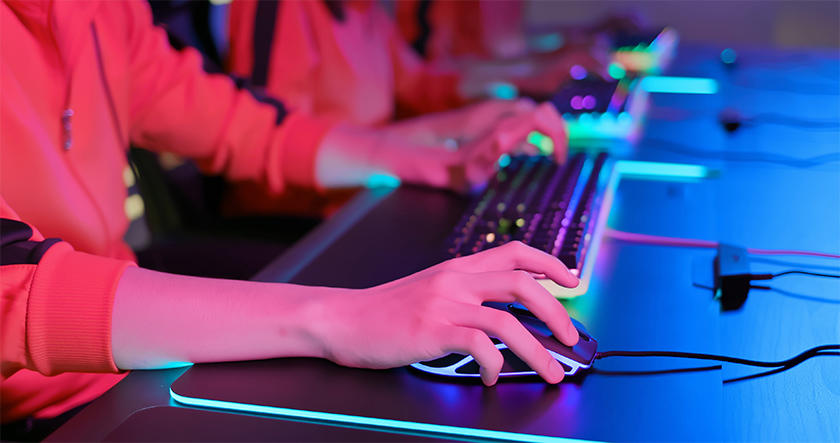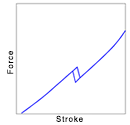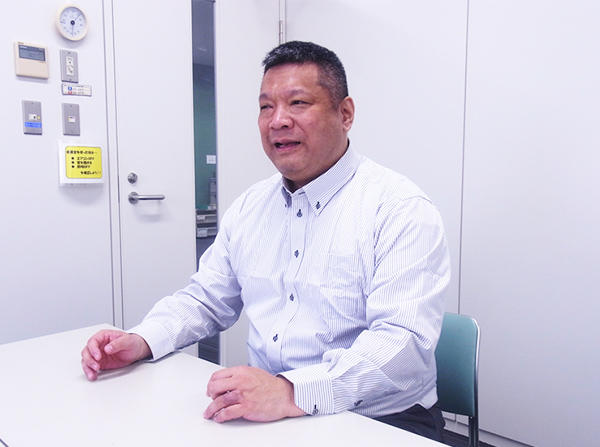Seeking the Ultimate Gaming Mouse for Professional Gamers
Can They Accurately Emulate the Sensation That People Feel Comfortable with?

With player numbers topping 100 million globally, eSports seems to know no boundaries. By definition, eSports is a form of sport competition involving video games. As long as you have the requisite devices, it does not matter how old you are or if you happen to be born as a male or a female, as anyone can join the competition from anywhere. Not surprisingly, eSports have spread all over the world. In recent years, the large scale competitions have been held with an increasing number of people making a living by gaming. eSports players use keyboards and mice for gaming to manipulate their in-game characters. As such, those gadgets must respond with extreme precision to players' will, and they must be exceedingly comfortable to operate. Profiled in this issue are OMRON engineers who pursue the "ideal click sensation" as they decipher human sensations and sensibility.
Are Click Sensations What Determines Who Is Winning/Losing?
To play eSports well, players need to manipulate their gadgets quickly, delicately, and precisely to instantly respond to changing situations, with the assistance of a gaming mouse. Every professional gamer and amateur player alike is super particular about the sensation that accompanies the click of a button (click sensation), as much as the shape and weight of the mouse, and in fact, it is one of the main criteria for their selection of a mouse. Just as professional sports players pay the utmost attention to their tools, for eSports players, their mouse is as important as a baseball bat or a racket as they might win or lose the game depending on which one they use. Now, the click sensation that gamers are so sensitive to is determined by an electronic component called a microswitch.
You might ask where in the mouse the microswitch can be found. It is placed underneath the mouse's button, and when a player clicks the button, a protuberance on the microswitch is pressed down. When the switch's contact opens/closes an electric circuit, the switch is turned on/off. The click sensation of the mouse is really the sensation of pressing down on the protuberance of the microswitch. Players talk about click sensation, using such expressions as "responding sharply" or "heavy/light."


OMRON's Computer Mouse Microswitch Popular for Its Exquisite Click Sensation
OMRON first encountered the computer mouse more than 30 years ago. Since the development of microswitches in 1943 for the first time in Japan, OMRON has consistently provided quality industrial-use microswitches that are compact, durable, and have less variation in operation. These switches came to be used in computer mice in the mid-1980s, when one consumer-use mouse after another was debuted. Computer mice that used OMRON's microswitches soon found high market acceptance for their click sensation.
OMRON then took one step further to come up with microswitches exclusively for computer mice with exceptional click sensation in the late 1990s.
At the time, OMRON engineers who were involved in the development of the microswitches studied what exactly it was about click sensation that users were so picky about. In doing so, they found that they could emulate click sensations by the matrix between the stroke (depth of push) until the switch reacts after the mouse is clicked and the intensity (force) of the clicking force.

OMRON then teamed up with a leading computer mouse manufacturer to develop a microswitch exclusively for computer mice. Achieving the optimal balance between strok and force, the brand-new microswitch began attracting immense support from users who could discern the differences between good and not-so-good click sensation. The technology was subsequently adapted for use in a variety of computer mice.
OMRON's New Challenge
Breaking Away from the Norm to Realize the Ideal Click Sensation That Professional Gamers Forever Seek
With the rapid growth of eSports in recent years, the kind of click sensation that gamers want from their computer mouse has become diversified. It is not just "heavy" or "light" as in the past, but they demand all sorts of click sensations, which they describe as "responds sharply," "gives me a premium feel," or "has a solid feel." These preferences are not given with specific numbers but conveyed with ambiguous terms based on human sensations. This being the case, developers are required to use microswitches to emulate the "ideal click sensation" with mere words as clues.
A team led by Isao Ozoe of the Technology Development Group of OMRON SWITCH & DEVICES embarked on a project to develop switches that emulate the ideal click sensation since 2016. Ironically, what baffled them initially was their successful experiences from the past: Following the conventional method, his team assembled a verification device that mechanically reproduced the relation between the stroke and force based on the sample that users evaluated as a most comfortable clicking feeling. However, the click sensation that the device reproduced was completely different from the one of the sample evaluated by the user.
"In retrospect, I relied only on my instinct, experiences, and groundless belief to develop the device. Because the device was developed based on the conventional measuring principle that we were so familiar with, we had no doubt that it would emulate the click sensation of the switch. When we tried the finished device to find that its click sensation was nowhere near that of the actual switch, I had no idea what was happening. We checked every possibility, hypothesizing it was due to insufficient specs or a problem with the drive system. We redid the device over and over again, but at the end of the day, there was little improvement. I was shocked, to be honest," Ozoe remembers.

(Department affiliations are at the time of development.)
After repeated discussions, Ozoe's team ended up with a technique for measuring click sensation by focusing on the feelings of human fingers.
"At the time, we were only concerned about what device we should make, which cannot be helped as we are a team of mechanical designers after all. Then one day, one of the members suddenly said, 'How do human fingers feel click sensation?' I felt like the scales falling from our eyes. We were preoccupied with the idea of emulating click sensation with a device and had not given any thought to how humans--or our fingers to be more specific--recognize that sensation. That was the moment we finally realized the need to go back to the drawing board and study the mechanism of how humans feel," recalls Ozoe.
The study of human fingers belonged to an uncharted field for his team, but they gathered the requisite knowledge by reading technical books and papers on finger feelings and soliciting instructions from university professors on the mechanism of human sensations, to conclude that gamers experience click sensations not merely through the feeling at their finger tips but through all five senses, including vision and hearing.
The measurement method thus developed by taking into account our five senses is capable of measuring fine differences in click sensations like "responds sharply" and "has a solid feel"--something conventional methods were not able to measure.
"Research into the human senses is a discipline that has begun to evolve only recently, and so we only know pieces of the broader puzzle. We thus need to repeat trials and errors every day. Yet, every member of my team perseveres and continues to work on this fairly challenging development project because we all genuinely believe that being able to measure and emulate human sensations accurately will serve to benefit future society.
As virtual reality (VR) technology continues to make profound strides these days, a number of devices that emulate virtual touch are being released, and we believe that VR will spread even further if we know exactly what 'real' sensations are. It is my hope that this microswitch development project will be the first step in a project that connects what is virtual with what is real," Ozoe spoke with enthusiasm.
Rie Shiraishi, a data analyst belonging to the same Group, spoke about her vision for their project: "Everything humans manipulate, computer mice included, has a specific feel to it. Going forward, we will roll out know-how on the operational sensations we learned from computer mice to many other devices humans manipulate. Our goal is to make it possible to design operational sensations that humans feel comfortable with through the five senses and then create ideal operational sensations on demand."

(Department affiliations are at the time of development.)
OMRON will continue to challenge itself to recreate the human senses.